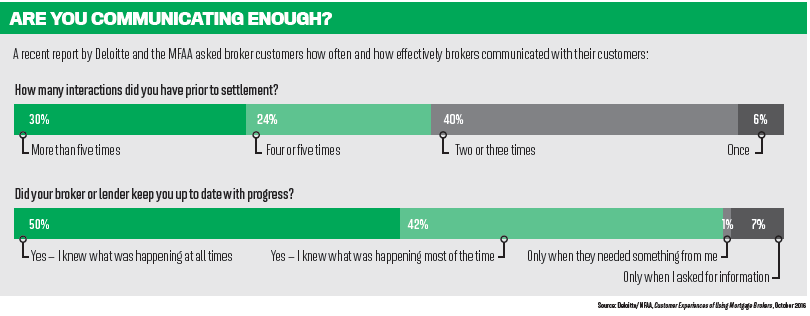Leadership expert Michelle Gibbings explains how you can take your face-to-face communication skills to the next level

Ever wondered how many words the average person speaks a day? Turns out it’s around 16,000 for women and 15,500 for men. However, much of what is said is never heard because humans are great at talking but less good at listening. We are often much more focused on what we want to say than what the other person is saying. And yet listening is crucial to building sustainable and healthy relationships – particularly with clients.
Your clients want to know that you understand them and their needs, and that you are able to help them reach their financial goals. The best way to do this is to be fully present when they speak to you and really hear what they are saying.
Listening isn’t easy
Listening takes practice and requires you to be in the best possible headspace and focused. And that means no distractions. However, the work environment is full of distractions. In a typical work day, you’ll rush from meeting to meeting, send a few emails, return a phone call, send an SMS, have a conversation with a team member, and then rush to your next client meeting. Sound familiar?
The problem is that when you’re rushing, it’s likely you’ll rush the client conversation too. You’ll say what matters to you but have less time to hear what the client really needs. If you are not in the right headspace your attention will be fractured and you are likely to be thinking about other things, rather than what the client needs from you.
Multitasking is a fallacy
Everyone loves to believe that they are brilliant at multitasking. However, the sad reality is that people can’t multitask. It’s a myth. When you multitask your attention is broken, and as you switch from one activity to another you lose concentration and ultimately become less productive. If you are talking on the phone to a client and checking emails at the same time you won’t be fully concentrating on what is being said. You may think you are listening, but you won’t hear the entire conversation or fully interpret the information being delivered. You’ll miss the subtle signals that your client may be sending you about what they are feeling and thinking.
At the same time, each time you switch from one task to another your brain is activated, and that uses up precious resources. The brain isn’t hardwired to handle multiple issues simultaneously or to rapidly switch back and forth between tasks.
David Rock, in his book Your Brain at Work, uses the metaphor of the prefrontal cortex as a stage. The prefrontal cortex is the part of the brain that handles functions such as thinking and decision-making. Issues arise when there are too many actors on your stage, each trying to play multiple scenes. He says, “While it is physically possible sometimes to do several mental tasks at once, accuracy and performance drop off quickly.”
The flipside is focus
Of course, people try to multitask and can be single-minded in what they need from a conversation because there is an incredible sense of busyness in today’s work environment. There always seems to be so much to do. But think about the flipside. In a highly competitive market in which the demands on advisers are continuing to increase, you can distinguish yourself from others by taking the time to really hear your clients.
They will see you are fully present and really listening to their needs. This builds trust and ultimately confidence in you and the service you provide – all of which helps you stand out and grow your business.
Reflect and learn
Having a conversation with a client go well and keeping it on track is the result of focus and preparation. But that’s not all. There’s often a key ingredient that’s overlooked, and that’s reflection.
It’s by reflecting on how the conversation went that you can gain deep insight into what worked, what didn’t work, what assumptions or bias was impacting on the conversation, and, most importantly, what you should do differently next time.
Taking the time to reflect creates the opportunity to learn more about ourselves and the other people involved in the conversation. After important client conversations ask yourself:


Your clients want to know that you understand them and their needs, and that you are able to help them reach their financial goals. The best way to do this is to be fully present when they speak to you and really hear what they are saying.
Listening isn’t easy
Listening takes practice and requires you to be in the best possible headspace and focused. And that means no distractions. However, the work environment is full of distractions. In a typical work day, you’ll rush from meeting to meeting, send a few emails, return a phone call, send an SMS, have a conversation with a team member, and then rush to your next client meeting. Sound familiar?
The problem is that when you’re rushing, it’s likely you’ll rush the client conversation too. You’ll say what matters to you but have less time to hear what the client really needs. If you are not in the right headspace your attention will be fractured and you are likely to be thinking about other things, rather than what the client needs from you.
Multitasking is a fallacy
Everyone loves to believe that they are brilliant at multitasking. However, the sad reality is that people can’t multitask. It’s a myth. When you multitask your attention is broken, and as you switch from one activity to another you lose concentration and ultimately become less productive. If you are talking on the phone to a client and checking emails at the same time you won’t be fully concentrating on what is being said. You may think you are listening, but you won’t hear the entire conversation or fully interpret the information being delivered. You’ll miss the subtle signals that your client may be sending you about what they are feeling and thinking.
At the same time, each time you switch from one task to another your brain is activated, and that uses up precious resources. The brain isn’t hardwired to handle multiple issues simultaneously or to rapidly switch back and forth between tasks.
David Rock, in his book Your Brain at Work, uses the metaphor of the prefrontal cortex as a stage. The prefrontal cortex is the part of the brain that handles functions such as thinking and decision-making. Issues arise when there are too many actors on your stage, each trying to play multiple scenes. He says, “While it is physically possible sometimes to do several mental tasks at once, accuracy and performance drop off quickly.”
The flipside is focus
Of course, people try to multitask and can be single-minded in what they need from a conversation because there is an incredible sense of busyness in today’s work environment. There always seems to be so much to do. But think about the flipside. In a highly competitive market in which the demands on advisers are continuing to increase, you can distinguish yourself from others by taking the time to really hear your clients.
They will see you are fully present and really listening to their needs. This builds trust and ultimately confidence in you and the service you provide – all of which helps you stand out and grow your business.
Reflect and learn
Having a conversation with a client go well and keeping it on track is the result of focus and preparation. But that’s not all. There’s often a key ingredient that’s overlooked, and that’s reflection.
It’s by reflecting on how the conversation went that you can gain deep insight into what worked, what didn’t work, what assumptions or bias was impacting on the conversation, and, most importantly, what you should do differently next time.
Taking the time to reflect creates the opportunity to learn more about ourselves and the other people involved in the conversation. After important client conversations ask yourself:
- How prepared was I for the conversation?
- What did I do during the conversation?
- Did the conversation progress as I expected? What surprised me?
- What was going on for me during the conversation, and how was I feeling? How did this change during the conversation?
- What do I think was going on for my client?
- Were there any assumptions or bias that may have impacted on the conversation?
- What was the outcome? Did I achieve what I set out to achieve?
- What would I do differently next time?
- Are there any follow-up or next steps required?


Michelle Gibbings is a change and leadership expert and founder of Change Meridian. Michelle works with global leaders and teams to help them accelerate progress in complex environments. She is the author of Step Up: How to Build Your Influence at Work. For more information, go to www.michellegibbings.com or contact [email protected].



